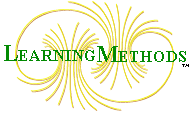 |
We already have within us what we need to solve our problems and transform our lives... We just have to learn to use it ! This is where LearningMethods comes in... |
On Belief Systems and Learning
A debate from the Alextech e-mail discussion group on the validity
of the premises of the Alexander Technique
Part 14
All contributions are copyright by their authors. Note that the e-mail addresses of the participants were valid at the time of the debate but may not be valid any longer.
Section Fourteen
— Continuing dialogues...
1. Joseph Boland — AT, etc. — June 14/01
From: Joseph Boland jeboland@yahoo.com
To: "David Gorman" deegee@learningmethods.com
Subject: AT, etc......
Date: Thu, 14 Jun 2001 20:43:59 -0700
DAVID....
If the enclosed would be of use to you, please use it.
Be well,
JOE
Mariposa, California / USA
FILE NOTES
Alexander started with a simple idea, to wit, the way we use ourselves has functional consequences and that misuse does not have to be a permanent condition. The procedure he developed, what we call the Alexander Technique, was his attempt to provide a practical procedure for restoring innate good use to the human organism.
Did Alexander see the "Technique" as a fait accompli, a finished product, or a final draft? I don’t think so, but it has been the dominant tendency of successive generations of teachers, students, and disciples to treat it as such and to pass it along with all the inherent flaws intact and labeled DO NOT TAMPER.
What Gorman is doing is in my view a welcome public challenge to the "keepers" of the Alexander Technique to resume a line of inquiry and experimentation that Alexander started and took, not to a point of completion, but just as far as he could in the time he had. If that means substantive rethinking of the Technique, then so be it; our priority should be to help people improve the way they use themselves by the most effective means possible, not to perpetuate a static process in the name of dogmatic purity. Having said that I can’t say I was impressed with or encouraged by the manner in which Gorman’s views were received on the alextech forum.
In my view Gorman is on the right track in dismissing the traditional fixation on an anatomy-specific "Primary Control" and the attendant ritual involving "directions". This has always been the weak link in the Technique and I believe there is evidence suggesting that even Alexander was coming to recognize as much, but like a bad habit it has persisted.
The Technique acknowledges the unification of mind and body but then proceeds to assume that misuse is essentially "physical" and that one can effect primary change by "being more aware" of use and mentally "directing" the body to do something else.
The disconnect is that if misuse is present and mind and body are unified then it is reasonable to suspect that one does not know how "to be aware" or to "think" and that in fact this is not an insignificant part of the problem, maybe even the cause.
It has been my working premise for a number of years that if there is such a thing as a "primary control", it is the way we perceive and interpret (or don’t) reality in the broadest sense of that word. This is not an original concept anymore than is "non-doing", both of which have been at the core of meditative practice for centuries and as a student of meditation I’ve found meditative practice and literature invaluable aids for developing a practical understanding of both concepts and, by extension, the Alexander Technique.
Misuse as defined in the Technique is a manifestation/symptom of perception and like Gorman I’ve found that the restoration of innate use follows the restoration of innate perception. I would even go as far as to say that it is the suspension of habitual "intellectual" perception that produces the pleasant kinesthetic byproduct that we associate with an Alexander lesson, not a preoccupation with directions, directing, and anatomy.
This is the END...
or maybe not... see below
Do you have anything to add to this debate?
After reading this debate, if you have any contributions you'd like to make to add to the debate, you can do so by sending an e-mail to: <debate at learningmethods.com> with your contribution. If you are responding to a particular posting, copy the reference from the Index or note it in your message. It may take a few days to get your response on-line so please be patient. You will be notified by e-mail when it has been uploaded.
![]()